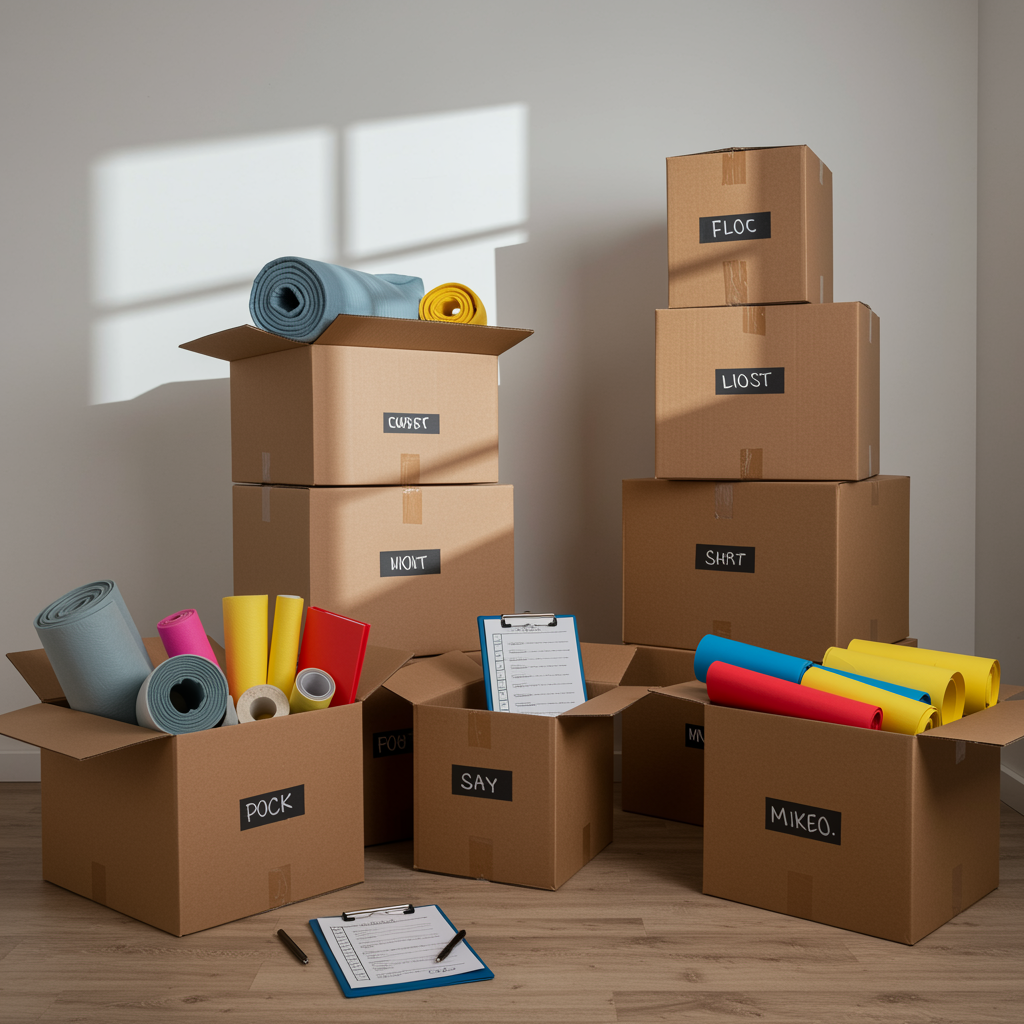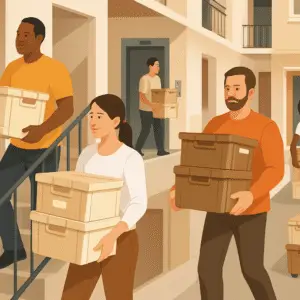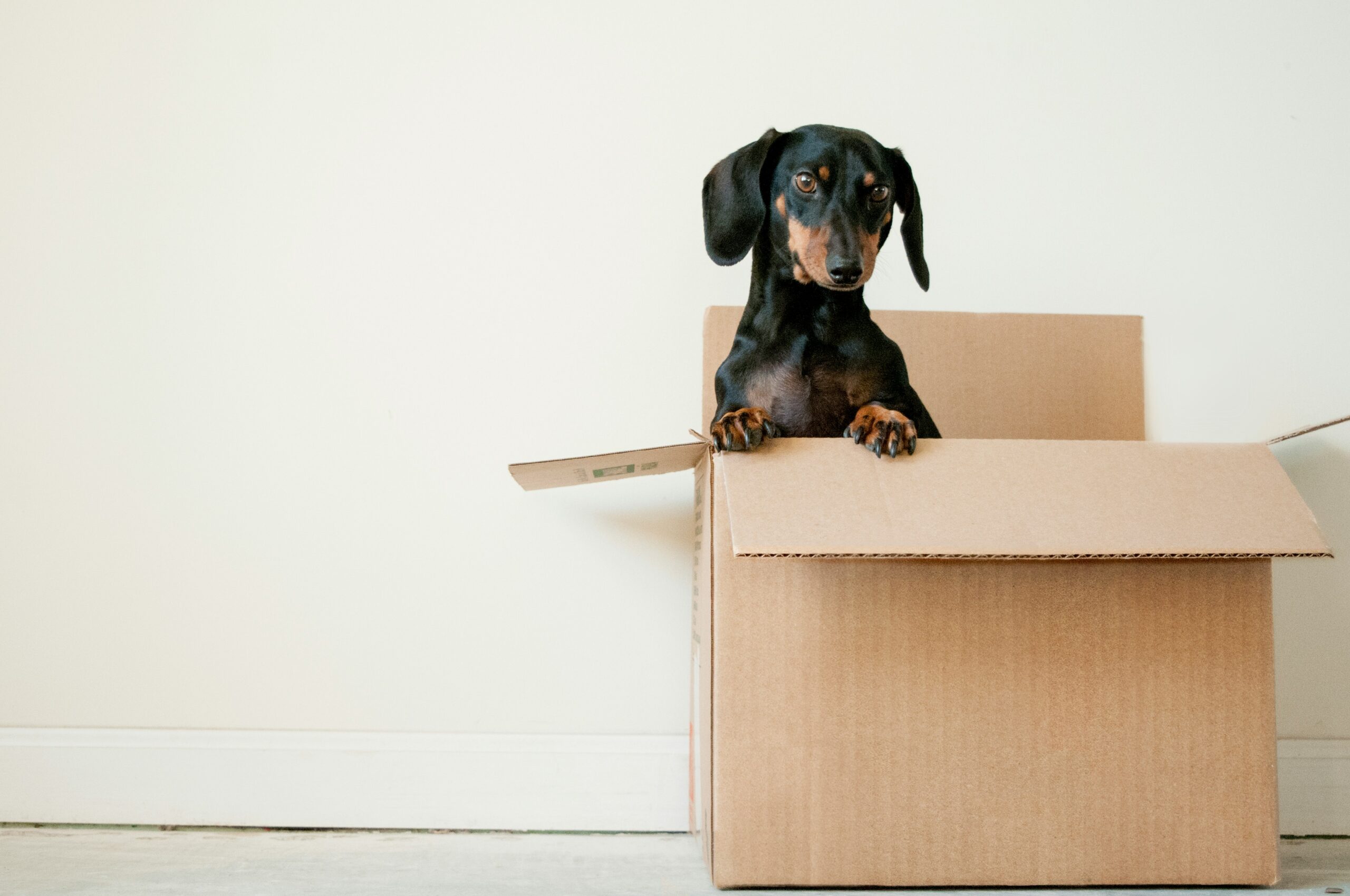The Moving Checklist That Actually Works
The Ultimate Moving Checklist That Will Transform Your Relocation Experience
Picture this: You’re standing in your empty old home, keys in hand, feeling absolutely triumphant instead of completely overwhelmed. Your boxes are labeled, your utilities are connected, and you actually know where your coffee maker is packed. Sounds like a fantasy? It’s not – it’s what happens when you follow a bulletproof moving checklist that covers every single detail from start to finish.
Moving doesn’t have to be the nightmare that 73% of Americans claim it to be. With the right moving checklist template and strategic planning, your relocation can actually be an exciting adventure rather than a stress-induced disaster. Whether you’re planning a cross-country move or just relocating across town, this comprehensive moving guide will walk you through every step of the process.
In 2025, the moving landscape has evolved significantly. Economic shifts and lifestyle changes are driving more Americans to relocate than ever before, with millions seeking better job opportunities, affordable living, and improved quality of life. This makes having a solid moving plan more crucial than ever.
Why Every Successful Move Starts With a Moving Checklist
Let’s be honest – moving is complex. There are dozens of moving tasks to juggle, from researching moving companies to updating your address with the postal service. Without a structured approach, even the most organized person can forget critical steps that turn moving day into moving nightmare.
Moving Industry Expert Sarah Chen, Professional Organizer: “The difference between a successful move and a chaotic one always comes down to preparation. I’ve helped over 500 families relocate, and those who use a detailed moving checklist report 40% less stress and save an average of $300 on their move. The secret is starting your moving preparation at least 8 weeks before your move date.”
A well-crafted moving checklist serves as your roadmap through the entire relocation process. It ensures you don’t overlook essential tasks like transferring utilities, updating insurance policies, or scheduling time off work. More importantly, it helps you budget properly and avoid last-minute expensive mistakes.
8 Weeks Before Moving Day: The Foundation Phase
Your moving journey begins two months before you actually pack a single box. This initial phase focuses on major decisions and bookings that require advance planning.
Research and Book Your Moving Company
Finding reliable movers is arguably the most critical item on your moving checklist. Start by getting quotes from at least three professional moving companies. The moving industry has embraced automation in 2025, making it easier to get instant quotes and compare services online.
When evaluating moving companies, verify their licenses and insurance coverage. Check reviews on multiple platforms and ask for references from recent customers. Don’t automatically choose the cheapest option – quality moving services are an investment in your peace of mind.
Create Your Moving Budget
Establish a realistic moving budget that accounts for all potential expenses. Beyond the obvious moving company costs, factor in packing supplies, storage fees, travel expenses, and utility deposits. Add a 20% buffer for unexpected costs – trust me, they always arise.
Start decluttering immediately. Go room by room and decide what to keep, donate, sell, or discard. This process not only reduces your moving costs but also gives you a fresh start in your new home. Create an inventory list of valuable items for insurance purposes.
6 Weeks Before: Paperwork and Logistics
Six weeks out is when your moving checklist becomes more administrative. This phase involves handling the paperwork and notifications that ensure a smooth transition.
School and Medical Records
If you have children, contact their current schools to request transcripts and transfer records. Research schools in your new area and understand their enrollment requirements. The same applies to medical records – request copies from doctors, dentists, veterinarians, and specialists.
Don’t forget about prescription medications. Ensure you have adequate supplies for the transition period, especially if you’re moving to a different state where your insurance coverage might temporarily be affected.
Dr. Michael Torres, Family Physician: “Medical record transfers can take several weeks, especially between different healthcare systems. I always advise patients to request their records early and carry a physical copy of essential information including current medications, allergies, and recent test results during their move.”
Insurance and Financial Preparations
Contact your insurance providers to update your policies. This includes homeowner’s or renter’s insurance, auto insurance, health insurance, and life insurance. Some policies may need to be cancelled and rewritten, while others simply require address updates.
Notify your bank and credit card companies about your upcoming move. This prevents your cards from being flagged for suspicious activity when you start making purchases in your new location. Consider opening an account with a bank that has branches in your new area if your current bank doesn’t.
4 Weeks Before: Service Transfers and Change of Address
One month before moving day, focus on transferring services and updating your address everywhere it matters. This is often the most tedious part of your moving checklist, but it’s absolutely essential.
Utility Transfers
Contact utility companies to schedule disconnection at your current home and connection at your new address. This includes electricity, gas, water, sewer, trash collection, internet, cable, and phone services. Schedule these transfers for the day before or day of your move to ensure you have power and utilities when you arrive.
Internet service deserves special attention. With more people working from home in 2025, having reliable internet connectivity from day one is crucial. Some providers require several weeks for installation, so prioritize this task.
Submit Change of Address Forms
File a change of address form with the postal service. You can do this online or at your local post office. The service typically costs around $1 online and provides mail forwarding for up to 12 months.
Update your address with all relevant organizations including your employer, IRS, state tax agencies, voter registration, vehicle registration, driver’s license, passport office, and any professional licenses you hold.
2 Weeks Before: Packing Preparation and Final Details
Two weeks before moving day, your checklist shifts into high gear. This is when the rubber meets the road, and your preparation pays off.
Gather Packing Supplies
Stock up on all necessary packing materials well in advance. Quality packing supplies are crucial for protecting your belongings during transport. You’ll need sturdy boxes in various sizes, packing tape, bubble wrap, packing paper, markers for labeling, and protective materials like foam or packing peanuts for fragile items.
Don’t forget specialty boxes for items like mirrors, artwork, or wardrobes. Many moving companies sell these supplies, but you can often find them cheaper at office supply stores or by asking local businesses for their used boxes.
Jennifer Walsh, Professional Packer with 15 years experience: “The biggest packing mistake I see is people underestimating how many boxes they need. A good rule of thumb is 10 boxes per room, plus extra for books and kitchen items. Always buy more packing tape than you think you need – you’ll use twice as much as expected.”
Start Packing Non-Essentials
Begin packing items you don’t use daily. Start with seasonal clothes, books, artwork, and decorative items. Label each box with its contents and destination room. Use a numbering system and keep a master list – this makes unpacking much more efficient.
Pack a “first day” box with essential items you’ll need immediately upon arrival: toiletries, medications, phone chargers, basic tools, snacks, coffee, and a change of clothes. This box should travel with you, not in the moving truck.
1 Week Before: Final Preparations
The final week is crunch time. Your moving checklist becomes increasingly detailed as you handle last-minute preparations.
Confirm All Arrangements
Call your moving company to confirm the moving date, time, and logistics. Verify the crew size, truck size, and estimated arrival time. Ask about payment methods and whether they require cash, check, or accept credit cards.
Confirm utility connections at your new home. There’s nothing worse than arriving at a new house with no electricity or water. Double-check that internet installation is scheduled if you’re working from home.
Pack an Essentials Suitcase
Pack as if you’re going on a week-long trip. Include several changes of clothes, toiletries, medications, important documents, and valuables. This suitcase stays with you during the move and ensures you have everything you need while boxes are being unpacked.
Prepare a cleaning kit for both homes. You’ll likely need to clean your old home after the movers leave and do some cleaning at your new home before fully settling in.
Moving Day: Execution and Oversight
Moving day has arrived! Your preparation pays off now as you execute your carefully planned moving checklist.
Morning Preparations
Start early and eat a good breakfast – moving day is physically and mentally demanding. Do a final walkthrough of your home, checking all rooms, closets, cabinets, and storage areas. Take photos or video for insurance purposes and as a record of your home’s condition.
Protect your floors and walls by laying down moving blankets or old towels. Use corner protectors on doorframes to prevent scratches and dings during the moving process.
Marcus Rodriguez, Moving Crew Supervisor: “The smoothest moves happen when homeowners are prepared but don’t micromanage. Have a plan, communicate clearly with the crew, and be available for questions. Keep important documents and valuables with you, and don’t pack a survival kit in the truck – you’ll want access to snacks, water, and phone chargers throughout the day.”
Working With Your Moving Crew
When the movers arrive, conduct a walkthrough together. Point out fragile items, valuable pieces, and any special handling requirements. Provide clear directions to your new home and your contact information.
Stay available but don’t hover. Professional movers work most efficiently when they can follow their established processes. Focus on tasks like final cleaning, managing paperwork, and handling any last-minute issues that arise.
Inventory and Documentation
Keep detailed inventory sheets provided by your movers. Note any existing damage and ensure both you and the crew supervisor sign off on the condition of items before they’re loaded. This documentation is crucial if you need to file insurance claims later.
Take photos of valuable items before they’re wrapped and loaded. This creates a visual record that can be helpful for insurance purposes and helps you remember how to reassemble complex items.
First Week in Your New Home: Settling In
Your moving checklist doesn’t end when the truck is unloaded. The first week in your new home is crucial for establishing routines and handling remaining logistics.
Immediate Priorities
Start by setting up essential areas: bathroom, bedroom, and kitchen basics. Having these functional spaces makes everything else manageable. Locate your circuit breaker, water shut-off valve, and heating/cooling controls – you’ll want to know where these are in case of emergencies.
Test all utilities and report any issues immediately. Check that internet, cable, and phone services are working properly. If something isn’t working, having it fixed quickly prevents disruption to work or school schedules.
Administrative Tasks
Update your driver’s license and vehicle registration according to your new state’s requirements. Most states require this within 30 days of establishing residency. Register to vote in your new location and update your address with the IRS.
Find new service providers: doctors, dentists, veterinarians, dry cleaners, and other professionals you’ll need. Ask neighbors for recommendations or research online reviews.
Special Considerations for Different Types of Moves
Not all moves are created equal. Your moving checklist may need modifications based on your specific situation.
Long-Distance Moves
Interstate moves require additional planning. Research your new state’s requirements for vehicle registration, driver’s licenses, and professional licenses. Some states have income tax implications that affect when you should officially establish residency.
Consider shipping some items separately if you’re driving to your new location. This might be more cost-effective for heavy items like books or off-season clothing.
International Moves
International relocations require extensive additional documentation. Research visa requirements, customs regulations, and import restrictions for your belongings. Some items that are legal in the US may be prohibited in other countries.
Plan for extended shipping times and potential delays. Important documents should be carried with you rather than shipped with household goods.
Lisa Chang, International Relocation Specialist: “International moves are completely different beasts. Start planning at least 6 months in advance, and budget for unexpected costs. The paperwork alone can be overwhelming, so consider hiring a relocation specialist who understands the customs and immigration requirements of your destination country.”
Technology Tools to Streamline Your Move
Take advantage of technology to make your moving process more efficient. Many apps and online tools can help you stay organized and save time.
Moving Apps and Digital Tools
Use moving apps to keep track of your checklist, inventory your belongings, and coordinate with your moving company. Many apps allow you to photograph items, track boxes, and share information with family members who are helping with the move.
Digital change-of-address services can update multiple accounts simultaneously, saving hours of individual notifications. While there’s usually a small fee, the time savings make it worthwhile for busy professionals.
Virtual Home Tours and Planning
If possible, take virtual tours of your new home before moving day. This helps you plan furniture placement and identify any potential challenges for the moving crew. Measure doorways, stairwells, and hallways to ensure your large furniture will fit.
Create a digital floor plan showing where furniture should go. Share this with your movers to speed up the unloading process and reduce confusion on moving day.
Common Moving Mistakes to Avoid
Learn from others’ mistakes to ensure your move goes smoothly. These common pitfalls can turn a well-planned move into a stressful ordeal.
Underestimating Time and Costs
Most people underestimate both the time required for moving tasks and the total cost of relocation. On average, it takes 7 days to several weeks to complete a move, including all packing, loading, transport, and unpacking activities.
Build buffer time into your schedule and budget. Last-minute rushes always cost more money and create unnecessary stress.
Poor Labeling and Organization
Inadequate labeling makes unpacking a nightmare. Use a detailed labeling system that includes both contents and destination room. Consider color-coding boxes by room for easy identification.
Pack a “first week” box for each room containing items you’ll need immediately. This prevents digging through multiple boxes to find basic necessities.
Making Your New House Feel Like Home
The final phase of your moving checklist focuses on settling in and making your new space comfortable.
Unpacking Strategy
Resist the urge to unpack everything immediately. Focus on one room at a time, starting with the most essential spaces. Complete each room fully before moving to the next – this gives you functional spaces to retreat to when other areas are chaotic.
Don’t feel pressured to decorate immediately. Live in your space for a few weeks to understand how you use different areas before making major decorating decisions.
Building Community Connections
Introduce yourself to neighbors and explore your new community. Join local groups, visit nearby businesses, and attend community events. Building connections makes your new location feel like home much faster.
Research local services and create a list of emergency contacts including nearest hospital, police station, fire department, and utility company emergency numbers.
Your Moving Success Story Starts Here
Moving doesn’t have to be a chaotic, stressful experience that leaves you exhausted and overwhelmed. With this comprehensive moving checklist, you have a roadmap for a successful relocation that keeps you organized, saves money, and reduces stress.
Remember that every successful move starts with early planning and attention to detail. The time you invest in following this checklist pays dividends in the form of a smooth, efficient moving experience.
Your new adventure awaits, and now you have the tools to make it happen seamlessly. From researching moving companies to settling into your new community, each step of this checklist brings you closer to successfully establishing your new home.
Take it one step at a time, stay organized, and don’t hesitate to ask for help when you need it. Moving is a major life transition, but with proper planning and the right checklist, it can be the beginning of an exciting new chapter rather than a stressful ordeal.
Happy moving, and welcome to your new home!
Keywords Used in This Article:
moving checklist, moving checklist template, moving guide, moving plan, moving tasks, moving companies, professional moving companies, moving day, relocation process, moving preparation, moving budget, packing supplies, moving services, change of address, utility transfers, moving tips, cross-country move, interstate moves, international moves, moving apps, digital tools, moving mistakes, unpacking strategy, new home, moving experience, moving process, long-distance moves, moving industry, moving trends 2025, moving costs, packing materials, moving crew, moving truck, household goods, moving timeline, address change, moving documentation, moving inventory, settling in, community connections, moving stress, successful move, moving logistics, moving arrangements
Meta Description:
“Master your move with this jaw-dropping checklist that transforms chaos into calm! Discover insider secrets, expert tips, and fail-proof strategies that guarantee your smoothest relocation ever. Don’t move without this!”
Feature Image Prompt:
A bright, organized scene showing neatly labeled moving boxes stacked in a clean, empty room with natural lighting streaming through windows. Include a clipboard with a checklist, colorful packing materials, and a warm, hopeful atmosphere that conveys preparation and success. The image should feel welcoming and professional, suggesting that moving can be organized and stress-free.











